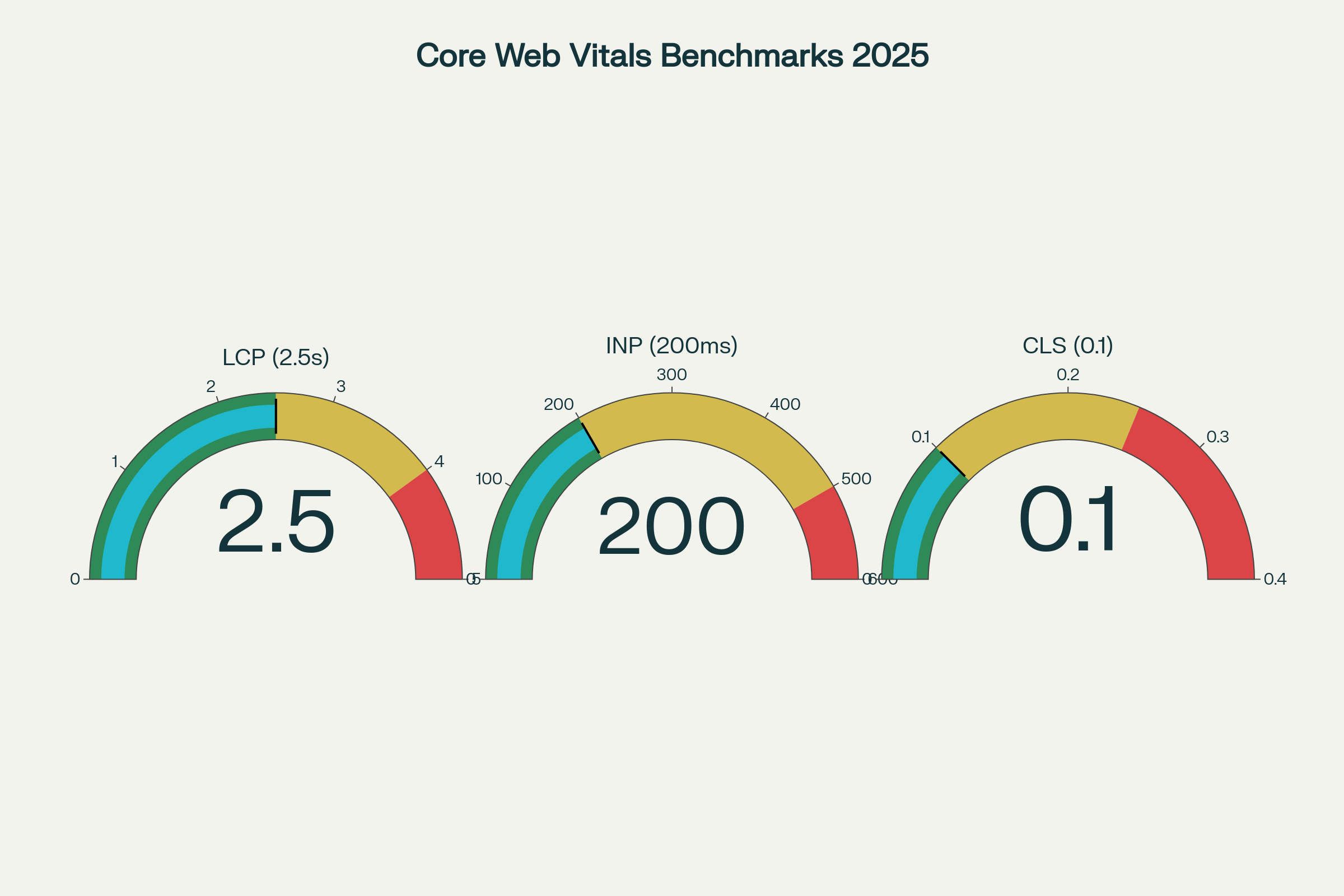Website speed isn’t just a nice-to-have—it’s a business-critical factor that directly impacts your bottom line. Studies show that a 1-second delay in page load time results in 7% fewer conversions, 11% fewer page views, and 16% decrease in customer satisfaction. With 43.6% of all websites powered by WordPress in 2025, optimizing your site’s performance has never been more crucial.
The reality is stark: 40% of users abandon websites that take more than 3 seconds to load, and Google’s Core Web Vitals have become essential ranking factors. For WordPress sites specifically, the average loading time is 2.5 seconds on desktop and 13.25 seconds on mobile—leaving massive room for improvement.
This comprehensive checklist provides 27 battle-tested techniques that successful WordPress agencies like Inspired Monks use to achieve sub-2-second load times while maintaining functionality and user experience.

Understanding WordPress Performance in 2025
but challenges remain. WordPress sites average 2.5 seconds load time on desktop, yet mobile performance lags at 13.25 seconds. This disparity highlights the urgent need for mobile-first optimization strategies.
Core Web Vitals have replaced traditional metrics, focusing on:
- Largest Contentful Paint (LCP): Should be under 2.5 seconds
- Interaction to Next Paint (INP): Target under 200 milliseconds
- Cumulative Layout Shift (CLS): Must stay below 0.1

Google Core Web Vitals benchmarks showing the performance thresholds for optimal WordPress website performance in 2025
The Business Impact of Speed
Performance directly correlates with revenue:
- E-commerce sites lose $1,190 for every 1,000 visitors when load times increase from 1 to 4 seconds
- Google prioritizes fast-loading sites in search rankings
- Mobile users, representing 56% of traffic, are especially sensitive to slow loading times
1. Caching Optimization (Techniques 1-5)
Technique 1: Implement Advanced Page Caching
Page caching is the single most impactful optimization, reducing server load by up to 72%. Modern caching plugins generate static HTML files, eliminating database queries for repeat visitors.
Best Caching Plugins for 2025:
- WP Rocket: Premium solution with 95% performance rating
- LiteSpeed Cache: Excellent for LiteSpeed servers
- W3 Total Cache: Feature-rich free option
- WP Super Cache: Reliable and lightweight

Implementation Steps:
- Install your chosen caching plugin
- Enable page caching with 1-month expiration
- Configure browser caching for static assets
- Set up cache preloading for critical pages
- Exclude sensitive pages (checkout, user accounts)
Technique 2: Database Query Caching
Object caching stores database query results in memory, reducing MySQL load by up to 60%. This is especially critical for sites with heavy database interactions.
Setup Process:
- Enable Redis or Memcached on your server
- Install object caching plugin support
- Configure persistent object caching
- Monitor cache hit rates (target 95%+)
Technique 3: Browser Caching Configuration
Browser caching leverages visitor’s local storage to avoid re-downloading unchanged resources. Properly configured, it can reduce bandwidth usage by 70%.
Optimal Caching Rules:
- Images: 1 year expiration
- CSS/JS: 1 month expiration
- HTML: 1 hour expiration
- Fonts: 1 year expiration
Technique 4: CDN Integration and Optimization
Content Delivery Networks reduce latency by 40-60% by serving content from geographically distributed servers. Cloudflare and QUIC.cloud lead CDN performance in 2025.
CDN Selection Criteria:
- Global PoP coverage: Minimum 50+ locations
- Dynamic content caching: Full page caching capability
- Smart routing: Automatic traffic optimization
- Security features: DDoS protection and WAF
- WordPress integration: Plugin compatibility
Technique 5: Advanced Caching Strategies
Fragment caching optimizes dynamic content sections while maintaining personalization. This technique is crucial for membership sites and e-commerce platforms.
Implementation:
- Cache static page sections separately
- Exclude user-specific content blocks
- Use ESI (Edge Side Includes) where supported
- Implement cache warming strategies
2. Image Optimization (Techniques 6-10)
Technique 6: Modern Image Format Conversion
WebP images provide 25-35% better compression than JPEG while maintaining quality. AVIF offers even better compression but requires broader browser support considerations.
Format Selection Guide:
- WebP: Best balance of compression and compatibility
- AVIF: Superior compression for modern browsers
- JPEG: Fallback for older browsers
- PNG: Preserve for images requiring transparency
Technique 7: Advanced Image Compression
Lossless compression reduces file sizes by 20-40% without quality degradation. Lossy compression can achieve 60-80% size reduction with minimal visual impact.
Recommended Tools:
- ShortPixel: Excellent compression ratios
- Smush Pro: WordPress integration
- Imagify: User-friendly interface
- EWWW Image Optimizer: Bulk optimization
Technique 8: Responsive Image Implementation
Serve appropriately sized images for different devices to reduce mobile bandwidth usage by up to 75%.
Implementation Strategy:
<img src="image-800.jpg"
srcset="image-400.jpg 400w,
image-800.jpg 800w,
image-1200.jpg 1200w"
sizes="(max-width: 400px) 400px,
(max-width: 800px) 800px,
1200px"
alt="Descriptive text">
Technique 9: Lazy Loading Optimization
Lazy loading defers off-screen image loading, reducing initial page weight by 60-70%. WordPress 5.5+ includes native lazy loading, but plugins offer enhanced control.
Best Practices:
- Exclude above-the-fold images from lazy loading
- Use intersection observer API for smooth loading
- Implement placeholder images or blurred previews
- Optimize for Core Web Vitals compatibility
Technique 10: Image Delivery Optimization
Optimize image delivery through proper sizing and loading strategies:
- Pre-size images: Upload images at exact display dimensions
- Use appropriate dimensions: Avoid CSS resizing
- Optimize thumbnails: Generate multiple size variants
- Implement progressive JPEG: For faster perceived loading
3. Code Optimization (Techniques 11-15)
Technique 11: CSS Minification and Optimization
Minifying CSS reduces file sizes by 20-30% by removing whitespace, comments, and redundant code. CSS optimization goes beyond minification to improve rendering performance.
Advanced CSS Techniques:
- Remove unused CSS rules (can reduce file size by 50%+)
- Inline critical CSS for above-the-fold content
- Defer non-critical CSS loading
- Use CSS containment for better rendering performance
Technique 12: JavaScript Optimization
JavaScript optimization is crucial for Core Web Vitals, particularly Interaction to Next Paint (INP). Defer JavaScript execution reduces blocking time by 40-60%.
Optimization Strategies:
- Defer non-critical JavaScript: Use defer or async attributes
- Remove unused JavaScript: Can reduce bundle size by 30-50%
- Code splitting: Load JavaScript on demand
- Optimize third-party scripts: Delay analytics and social widgets
Technique 13: HTML Optimization
Clean HTML structure improves parsing speed and reduces document size:
- Remove unnecessary HTML comments and whitespace
- Optimize DOM structure (aim for <1,500 elements per page)
- Use semantic HTML for better performance
- Minimize inline styles and scripts
Technique 14: Database Optimization
Database optimization reduces query execution time by 40-70%. WordPress databases accumulate significant bloat over time.
Essential Database Tasks:
- Remove spam comments and post revisions
- Clean up expired transients and options
- Optimize database tables monthly
- Remove unused plugins and themes data
- Implement database query caching
Recommended Plugins:
- WP-Optimize: Comprehensive database cleaning
- WP Reset: Complete database management
- Advanced Database Cleaner: Detailed optimization
Technique 15: Plugin Performance Auditing
Poorly coded plugins can slow sites by 200-300%. Regular plugin auditing is essential for maintaining performance.
Plugin Audit Process:
- Monitor plugin impact: Use Query Monitor or similar tools
- Identify resource-heavy plugins: Check database queries and HTTP requests
- Find alternatives: Replace heavy plugins with lighter options
- Disable unnecessary plugins: Remove plugins not actively used
- Keep plugins updated: Outdated plugins cause 95% of vulnerabilities
4. Mobile Optimization (Techniques 16-20)
Technique 16: Mobile-First Design Implementation
Mobile traffic represents 58.33% of global website traffic9, making mobile-first optimization critical. Mobile WordPress sites average 13.25 seconds load time – 5x slower than desktop.
Mobile Optimization Priorities:
- Choose lightweight, responsive themes
- Optimize touch targets (minimum 44×44 pixels)
- Simplify navigation for mobile users
- Prioritize above-the-fold content loading
Technique 17: AMP Implementation (When Appropriate)
Accelerated Mobile Pages (AMP) can improve mobile load times by 50-85% for content-heavy sites. However, AMP requires careful consideration of functionality trade-offs.
AMP Benefits:
- Near-instant loading on mobile devices
- Priority treatment in Google search results
- Reduced bandwidth consumption
- Simplified mobile experience
AMP Considerations:
- Limited JavaScript functionality
- Restricted design flexibility
- Separate mobile experience maintenance
- Not suitable for all website types
Technique 18: Mobile Caching Strategies
Mobile-specific caching addresses unique mobile challenges:
- Separate mobile cache: Different caching rules for mobile devices
- Touch-optimized interfaces: Faster tap response times
- Reduced cache sizes: Smaller cache files for mobile bandwidth
- Offline caching: Service worker implementation for offline access
Technique 19: Mobile Image Optimization
Mobile image optimization requires specific strategies beyond general optimization:
- Smaller initial images: 50% smaller base images for mobile
- Progressive loading: Show low-quality previews first
- Network-aware loading: Adjust quality based on connection speed
- Viewport-based sizing: Serve images sized for mobile screens
Technique 20: Mobile Performance Monitoring
Monitor mobile performance separately as metrics differ significantly from desktop:
- Test on real devices: Simulators don’t reflect real performance
- Monitor 3G/4G performance: Test various connection speeds
- Track mobile-specific metrics: Touch delay, scroll performance
- Use mobile-first testing tools: Lighthouse mobile audits
5. Server and Hosting Optimization (Techniques 21-25)
Technique 21: Choose Performance-Optimized Hosting
Hosting choice impacts performance more than any other factor. Managed WordPress hosting providers deliver 40-60% better performance than shared hosting.
Top Performing WordPress Hosts (2025):
- Hostinger: 915ms average load time, 100% uptime
- Liquid Web: 836ms load time with SLA guarantee
- SiteGround: 417ms load time, excellent support
- WP Engine: 656ms load time, enterprise features
Hosting Performance Factors:
- Server specifications: Minimum 4vCPU, 4GB RAM, NVMe storage
- PHP version: PHP 8.0+ with OpCache enabled
- Server location: Choose closest to target audience
- Scalability options: Auto-scaling for traffic spikes
Technique 22: Server-Level Optimizations
Server configuration optimizations can improve performance by 30-50%:
PHP Optimization:
- Enable OpCache: 128MB+ memory allocation
- Use PHP-FPM: 20+ worker processes
- Optimize PHP settings: Increase memory limits and execution time
- Regular PHP updates: Latest stable version
Database Optimization:
- MySQL tuning: Optimize query cache and buffer sizes
- Use SSD storage: 3-5x faster than traditional HDDs
- Enable query caching: Reduce database load
- Regular maintenance: Optimize tables and indexes
Technique 23: Content Delivery Network (CDN) Setup
CDN implementation reduces global load times by 40-72%. Cloudflare and QUIC.cloud lead 2025 CDN performance.
CDN Configuration Best Practices:
- Global coverage: Minimum 50+ edge locations
- Full page caching: Cache HTML, not just assets
- Smart routing: Optimize traffic paths automatically
- Security integration: WAF and DDoS protection
- Analytics integration: Monitor performance improvements
Technique 24: HTTP/2 and HTTP/3 Implementation
HTTP/2 provides 20-30% performance improvements through multiplexing and server push. HTTP/3 offers additional 10-15% gains with UDP-based transport.
Implementation Benefits:
- Multiplexing: Multiple requests over single connection
- Header compression: Reduced overhead
- Server push: Preload critical resources
- Improved security: Enhanced encryption
Technique 25: SSL/TLS Optimization
SSL/TLS optimization prevents security from impacting performance:
- Use modern TLS versions: TLS 1.3 for better performance
- Optimize certificate chains: Minimize handshake time
- Enable OCSP stapling: Reduce certificate verification time
- Use CDN SSL termination: Offload encryption processing
6. Advanced Optimization Techniques (Techniques 26-27)
Technique 26: Core Web Vitals Specific Optimizations
Core Web Vitals optimization requires targeted approaches for each metric:
Largest Contentful Paint (LCP) Optimization:
- Optimize server response time: Target TTFB under 800ms
- Preload key resources: Critical images and fonts
- Remove render-blocking resources: Defer non-critical CSS/JS
- Use efficient image formats: WebP or AVIF for hero images
Interaction to Next Paint (INP) Optimization:
- Minimize JavaScript execution time: Code splitting and lazy loading
- Optimize event handlers: Debounce and throttle user interactions
- Break up long tasks: Use setTimeout for heavy computations
- Prioritize visible interactions: Focus on above-the-fold elements
Cumulative Layout Shift (CLS) Optimization:
- Set image dimensions: Prevent layout shifts during loading
- Reserve space for ads: Use placeholder dimensions
- Avoid dynamic content insertion: Plan for expanding content
- Font loading optimization: Use font-display: swap
Technique 27: Performance Monitoring and Continuous Optimization
Continuous performance monitoring ensures sustained optimization. Set up automated monitoring to catch performance regressions early.
Essential Monitoring Tools:
- Google PageSpeed Insights: Official Core Web Vitals testing
- GTmetrix: Comprehensive performance analysis
- WebPageTest: Advanced testing scenarios
- Real User Monitoring: Track actual visitor experience
Monitoring Best Practices:
- Test multiple pages: Not just homepage performance
- Monitor mobile and desktop: Separate performance tracking
- Set performance budgets: Alert on performance degradations
- Regular audit schedule: Monthly comprehensive reviews
- Track business metrics: Correlate performance with conversions
WordPress Speed Testing and Measurement
Essential Testing Tools for 2025
Comprehensive testing requires multiple tools to get accurate performance insights:
Free Testing Tools:
- Google PageSpeed Insights: Core Web Vitals and recommendations
- GTmetrix: Waterfall analysis and historical tracking
- WebPageTest: Advanced configuration options
- Lighthouse: Built into Chrome DevTools
WordPress-Specific Tools:
- Query Monitor: WordPress plugin for database query analysis
- Debug Bar: WordPress debugging for developers
- New Relic: Application performance monitoring
- Kinsta APM: WordPress-specific performance insights
Creating a Performance Testing Routine
Establish regular testing procedures:
- Pre-deployment testing: Test all changes before going live
- Weekly automated tests: Monitor performance trends
- Post-update audits: Verify plugin/theme updates don’t impact performance
- Monthly comprehensive reviews: Full performance audit
- Quarterly optimization sprints: Implement new optimization techniques
Implementation Priority Framework
Phase 1: Quick Wins (Week 1)
Immediate impact optimizations:
- Install caching plugin (WP Rocket or alternative)
- Enable image compression
- Optimize images already uploaded
- Remove unused plugins
- Update to latest PHP version
Phase 2: Foundation Building (Weeks 2-4)
Structural improvements:
- Implement CDN
- Database optimization and cleanup
- Choose performance-optimized hosting
- Set up performance monitoring
- Optimize theme and remove bloat
Phase 3: Advanced Optimization (Ongoing)
Continuous improvement:
- Core Web Vitals optimization
- Mobile-specific improvements
- Server-level optimizations
- Custom code optimization
- Regular performance audits
Common WordPress Speed Optimization Mistakes
Mistake 1: Over-Optimization
Too many optimization plugins can conflict and actually slow down your site. Use complementary plugins, not competing ones.
Mistake 2: Ignoring Mobile Performance
Mobile optimization requires separate attention. Desktop optimization doesn’t automatically improve mobile performance.
Mistake 3: Not Testing Changes
Always test performance changes individually to understand their impact. Use staging environments for testing.
Mistake 4: Focusing Only on Testing Scores
Optimize for real user experience, not just testing tool scores. Business metrics matter more than perfect scores.
Mistake 5: Neglecting Ongoing Maintenance
Performance optimization requires continuous attention. Set up monitoring and regular maintenance schedules.
Measuring Success: Key Performance Indicators
Technical Metrics
- Page load time: Target under 2 seconds
- Time to First Byte (TTFB): Under 800ms
- Core Web Vitals: All metrics in “Good” range
- Mobile page speed: Under 3 seconds on 3G
Business Metrics
- Bounce rate reduction: 10-20% improvement expected
- Conversion rate increase: 3-5% uplift typical
- Search ranking improvements: Track keyword positions
- User engagement: Session duration and pages per visit
WordPress Speed Optimization ROI
Performance optimization delivers measurable business returns:
- E-commerce sites: 1% speed improvement = 2% conversion increase
- Lead generation: Faster sites generate 25% more leads
- SEO benefits: Speed improvements correlate with ranking gains
- User satisfaction: Faster sites have 16% higher customer satisfaction
Investment vs. Returns:
- Initial optimization cost: $2,000-$5,000 for professional services
- Annual maintenance: $1,200-$3,000 for ongoing optimization
- Revenue impact: 10-25% increase in conversions typical
- ROI timeline: 3-6 months for full optimization benefits
Conclusion: Building Lightning-Fast WordPress Sites
WordPress speed optimization in 2025 requires a comprehensive, methodical approach combining technical expertise with strategic implementation. These 27 techniques provide a complete framework for achieving exceptional performance while maintaining functionality and user experience.
Success depends on three critical factors:
- Systematic implementation: Follow the priority framework rather than random optimization
- Continuous monitoring: Performance optimization is ongoing, not one-time
- Business-focused metrics: Optimize for conversions and user experience, not just test scores
The performance landscape continues evolving, with new technologies like HTTP/3, WebAssembly, and advanced caching strategies emerging. However, the fundamentals remain constant: fast sites provide better user experiences, higher search rankings, and increased business success.
For businesses serious about WordPress performance, partnering with experienced agencies like Inspired Monks ensures professional implementation of these optimization techniques. Their 4-week launch guarantee and proven optimization methodologies help businesses achieve sub-2-second load times while maintaining full website functionality.
Remember: Every 100ms of speed improvement can increase conversions by 1%. In today’s competitive digital landscape, WordPress speed optimization isn’t optional—it’s essential for business success.
Start with the quick wins, build systematic optimization processes, and monitor continuously. Your users, search rankings, and bottom line will thank you for the investment in performance excellence.
